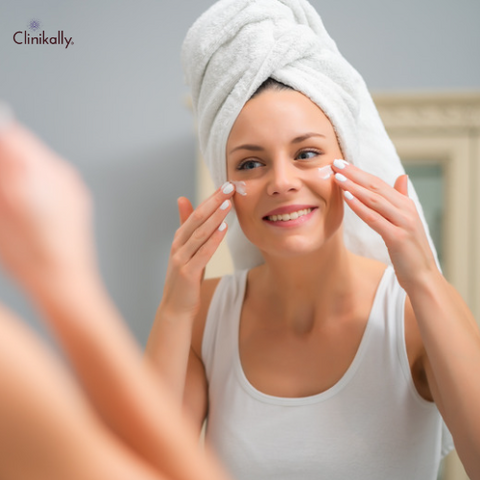In the quest for flawless beauty, new makeup techniques and trends constantly emerge, offering innovative ways to enhance our features and achieve a radiant complexion. One such trend that has gained considerable popularity in recent years is sunscreen contouring. Promising a sun-kissed glow while simultaneously protecting the skin from harmful UV rays, sunscreen contouring has become a go-to technique for many beauty enthusiasts.
The concept behind sunscreen contouring is rather straightforward. By strategically applying layers of sunscreen with varying SPF levels to different areas of the face, individuals can mimic the effect of traditional contouring, creating the illusion of sculpted cheekbones, a slimmer nose, and a more defined jawline, all while safeguarding their skin from the sun's damaging rays. This technique appears to offer the best of both worlds: an effortless and glamorous makeup look coupled with the essential protection against sunburns and skin damage.
However, beneath the surface, this seemingly harmless trend may be doing more harm than good. While the concept of sunscreen contouring may sound appealing, several concerns have been raised by dermatologists and skincare experts regarding its safety and effectiveness. In this blog post, we will delve deeper into the dangers of sunscreen contouring, shedding light on the potential risks it poses to your skin and why it may not be the ideal approach to sun protection.
What is Sunscreen Contouring and How Does it Work?

Before delving into the risks, let's first understand what sunscreen contouring is and how it works. Sunscreen contouring involves the strategic application of different shades of sunscreen to create depth, dimension, and a contoured look on the face. Similar to traditional makeup contouring, this technique uses lighter and darker shades of sunscreen to highlight and shade specific areas of the face, giving the appearance of a sculpted complexion.
Understanding the Basics of Sunscreen Contouring
To grasp the concept of sunscreen contouring, it is crucial to understand the purpose of sunscreen itself. Sunscreen is a product designed to protect the skin from the harmful effects of ultraviolet (UV) radiation, which can cause sunburn, premature aging, and even skin cancer. Sunscreens work by either physically blocking or chemically absorbing UV rays, depending on their active ingredients.
Common Makeup Techniques Used for Sunscreen Contouring
Sunscreen contouring typically involves using different shades of sunscreen with varying sun protection factor (SPF) levels. Lighter shades with higher SPF are applied to areas that are meant to be highlighted, while darker shades with lower SPF are used to contour and create shadows on the face. This technique aims to provide both sun protection and a desired aesthetic effect.
Why Sunscreen Contouring Can Be Dangerous for Your Skin

Although sunscreen contouring may seem like a clever way to combine makeup and sun protection, it can actually be detrimental to your skin. There are two main reasons why this technique can be dangerous: harmful ingredients and the risks associated with improper application.
Sunscreen Ingredients That Can Harm Your Skin
Not all sunscreen ingredients are created equal. Some common ingredients found in sunscreens, such as oxybenzone and octinoxate, have raised concerns due to their potential for skin irritation, allergic reactions, and hormone disruption. These ingredients are also known to be harmful to marine life when washed off into the water. Additionally, certain fragrances and preservatives in sunscreen formulations can further irritate the skin, especially for those with sensitive skin types.
Risks of Using Sunscreen Contouring Techniques
The application of multiple layers of sunscreen, especially in different shades, can lead to uneven coverage and inadequate sun protection. Sunscreen contouring often involves using lower SPF products on certain areas of the face, which can leave those areas vulnerable to UV damage. Inconsistent application can result in patchy sun protection and increase the risk of sunburn and long-term skin damage.
Moreover, sunscreen contouring may create a false sense of security. People who rely solely on this technique may assume that they are adequately protected from the sun's harmful rays, neglecting other essential sun protection practices such as seeking shade, wearing protective clothing, and reapplying sunscreen regularly.
How to Protect Your Skin from the Sun Without Sunscreen Contouring

Given the risks associated with sunscreen contouring, it is crucial to find alternative methods to protect your skin from the sun. Here are some safe sun protection practices for maintaining healthy skin:
Safe Sun Protection Practices for Healthy Skin
-
Apply sunscreen generously to all exposed areas of your skin at least 15 minutes before sun exposure. Choose a broad-spectrum sunscreen with a minimum SPF of 30, which will protect against both UVA and UVB rays.
-
Reapply sunscreen every two hours, or more frequently if you're sweating or swimming. This ensures continuous protection throughout the day.
-
Seek shade during peak sun hours, typically between 10 a.m. and 4 p.m., when the sun's rays are strongest. If you must be outdoors, try to stay in shaded areas or create your own shade using umbrellas or wide-brimmed hats.
-
Wear protective clothing, such as long-sleeved shirts, pants, and wide-brimmed hats. Look for clothing with a UPF (Ultraviolet Protection Factor) rating for added sun protection.
-
Use sunglasses that block 100% of UVA and UVB rays to protect your eyes and the delicate skin around them.
-
Incorporate antioxidant-rich foods into your diet. Antioxidants help neutralize free radicals caused by UV exposure and promote overall skin health. Include fruits, vegetables, nuts, and seeds in your meals.
-
Stay hydrated by drinking plenty of water. Hydrated skin is more resilient and better able to protect itself from sun damage.
-
Don't forget about your lips. Apply a lip balm with SPF to keep them protected from the sun's rays.
Tips for Applying Sunscreen Effectively
To maximize the effectiveness of your sunscreen and ensure even coverage, keep the following tips in mind:
-
Apply sunscreen to all exposed areas of your body, including your face, neck, ears, and the backs of your hands and feet.
-
Use enough sunscreen to cover the entire area. As a general guideline, a shot glass full of sunscreen is recommended for the entire body.
-
Massage the sunscreen into your skin until it is fully absorbed. This helps to ensure even distribution and optimal protection.
-
Pay attention to commonly overlooked areas, such as the tops of your ears, the back of your neck, and the part in your hair.
-
Don't forget to protect areas that are often neglected, such as the tops of your feet and the backs of your hands.
When to Seek Help from a Dermatologist
While practicing safe sun protection habits is essential, it's also important to be aware of the signs of sun damage and when to seek professional help. A dermatologist can provide expert advice, diagnose skin conditions, and offer appropriate treatment. Here are some signs that indicate it's time to consult a dermatologist:
Signs of Sun Damage to Your Skin
-
Sunburn: One of the most immediate and recognizable signs of sun damage is sunburn. When your skin is exposed to excessive UV radiation, it can become red, swollen, and painful. Sunburns vary in severity, with mild cases causing discomfort and peeling, while severe sunburns can blister and require medical attention. It's important to protect your skin from the sun to prevent sunburns, as they indicate that the skin has been damaged by UV rays.
-
Changes in Moles or Pigmented Areas: Regularly monitoring your moles and pigmented areas is crucial for early detection of skin cancer. Exposure to UV radiation can contribute to the development of abnormal moles or melanoma, a potentially deadly form of skin cancer. Pay attention to any changes in the size, shape, color, or texture of existing moles or pigmented areas. If you notice asymmetry, irregular borders, changes in color, diameter larger than a pencil eraser, or any evolving characteristics, it is essential to consult a dermatologist for further evaluation.
-
Premature Aging: Excessive sun exposure can accelerate the aging process of the skin, leading to premature aging signs such as wrinkles, fine lines, and age spots. UV rays penetrate the skin and damage collagen and elastin fibers, which are responsible for maintaining the skin's elasticity and firmness. Over time, this can result in the formation of deep wrinkles, sagging skin, and a loss of youthful appearance. Dermatologists can provide treatments and recommend skincare routines to help minimize the visible signs of aging caused by sun damage.
-
Uneven Skin Tone and Hyperpigmentation: Prolonged sun exposure can cause uneven distribution of melanin, the pigment responsible for skin color. This can result in the development of hyperpigmentation, where certain areas of the skin appear darker than others. Common examples include sunspots, freckles, and melasma. These pigmentation issues can be challenging to treat and may require specialized skincare products, chemical peels, or laser treatments to reduce their appearance.
-
Actinic Keratosis: Actinic keratosis is a precancerous condition characterized by rough, scaly patches on the skin. These patches are usually the result of cumulative sun damage and are more commonly found on sun-exposed areas such as the face, scalp, hands, and forearms. Actinic keratosis should be evaluated by a dermatologist, as they have the potential to develop into squamous cell carcinoma, a type of skin cancer.
-
Weakened Immune System: Prolonged exposure to UV radiation can suppress the immune system, making the skin more vulnerable to infections, including viral, bacterial, and fungal infections. This can lead to skin conditions such as herpes simplex outbreaks, cold sores, and even the development of skin cancers.
It is crucial to be aware of these signs of sun damage and take appropriate measures to protect your skin from the harmful effects of UV radiation. Regular use of broad-spectrum sunscreen, seeking shade during peak sunlight hours, wearing protective clothing, and using hats and sunglasses are all essential steps in maintaining skin health and preventing sun-related damage.
Warning Signs of Skin Cancer and Other Skin Conditions
-
New or Changing Skin Growths: Keep an eye out for new growths on your skin or existing growths that change in size, shape, color, or texture. These changes could indicate skin cancer or other skin conditions.
-
Irregular Borders or Asymmetry: Pay attention to any irregular or uneven borders of moles or skin lesions, as well as any noticeable asymmetry. These can be warning signs of skin cancer









































